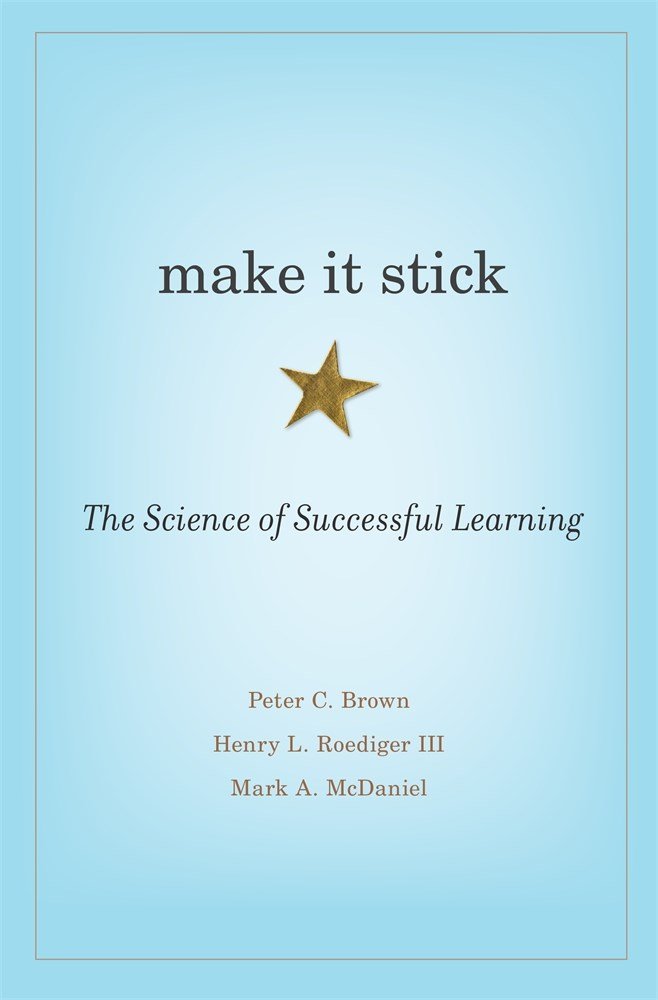
Title: Make It Stick: The Science of Successful Learning
Authors: Peter C. Brown (Bio), Henry L. Roediger III (Bio), Mark A. McDaniel (Bio)
My opinion of this book: This is a fantastic and eye-opening book on learning and memory. This book is more or less the bible of the competitive memorizer crowd, and for good reason. It’s not just some guy with ideas he came up with. The authors (two of them) are learning and brain scientists. With loads of studies and evidence they expose myths and share ways to learn more effectively. They really dig into the studies, so if you are an eager type you could skim, but some of these ideas are so counter-intuitive you might need to read about the studies to be fully convinced.
Should You Read This Book?
If you have these challenges:
You are tired of reading or “learning” things, just to forget them in a few days or weeks.
You have a learning project and you want to make the best use of your time.
You want to help others learn something.
… then it might help you because:
It gives you science-tested practices that help you remember more in a shorter amount of time.
It exposes popular beliefs about learning and remembering that are false and sometimes even detrimental.
But you might not want to read it if:
You want learning to be fun and easy or are looking for shortcuts or hacks.
What I Got Out Of This Book
Learning is Not “Fun”.
The number one thing I learned (and I’m sorry to have to tell you this if you don’t already know): Learning requires strain and effort. Making learning “fun” usually means you have made it easy and you’re not learning as well or as quickly.
I know. This is very disappointing news.
I wouldn’t blame you for saying “there must be another way”. And then pointing out all the many apps and books and classes that claim to “make learning fun”.
But when you learn you are asking your brain to change and the brain really doesn’t like to change. So it’s not terribly pleasant. It’s not necessarily unpleasant – but there is a sense of strain and struggle.
Reviewing The Material Isn’t As Useful As You’d Think
Just sitting with the book closed and trying to remember stuff has been shown to be more useful than reading the material a second time. Many experiments have shown that weeks later the people who just strained to remember in their heads and never looked at the material again did better than those that re-read the material.
Testing Isn’t Just For Checking Your Progress
Retrieval is how we remember. Testing is not just for seeing how well you know stuff. Testing actually forces you to strain and recall things. The act of straining to recall – in and of itself – helps you remember things more. So building self-testing into your study habits can be an effective learning tool.
Cramming Doesn’t Help You Learn
“Massed Practice” is when you study a block of similar material in the same sitting. This is how many people study. It’s not as effective as “Interleaving Practice” which is studying a little of this then a little of that, quitting each before you really get it. And It’s not as effective as studying it for shorter lengths but repeated over time (known as “spaced repetition”).
Guessing What You Will Learn Before You Learn Anything Helps You Learn
If, before you even open the book for the first time, you try to write out what you think you will learn, you will learn more when you read. Even if you guessed completely wrong.
I found this hard to believe but there’s loads of evidence to back this up.
The Fluency Illusion (Or, Why I Don’t Remember That Book I Read Last Week Even Though I Swear It Was Great)
“Passively learning”, for example, watching a lecture or listening to a podcast or reading a book can convince us that we have learned. What has learned is our short-term memory, though. Not the long-term. Short-term memory is expunged often, so we don’t really learn much. This is “the fluency illusion”. “Fluency Illusions result from our tendency to mistake fluency with a text for mastery of its content.”
Learning Styles Are Bunk
There has never been evidence to support so-called “learning styles”. Studies have been done on people who claim themselves “visual learners” or “auditory learners” and they don’t learn better than one another in their “styles”. They might have a preference and enjoy one more than the other, but they don’t actually learn more using it than they would some other style. It’s better to match the style to the subject matter to achieve optimal learning.
Adopting a Growth Mindset, applying Deliberate Practice, and constructing memory cues serve as “cognitive multipliers”. The first two come up again and again in the books I read and I believe that’s because they are some of the most powerful techniques we can use for self-growth.
There’s So Much More
I’ve only shared some of the things I learned from this book to give you an idea of what you might expect. There’s a lot more in this book and if you’ve found these ideas interseting, I encourage you to read it.